Workplace Environment
>
Doleole
>
La toile du vivant
>
The Web of Life
>
What is coaching
>
Professional Development
>
Professional Environment
>
Quality Of Working Life
Here's Proof That Office Layout Doesn't Affect Productivity. There has long been a heated debate as to which type of workplace layout is the best for productivity: Cubicles?
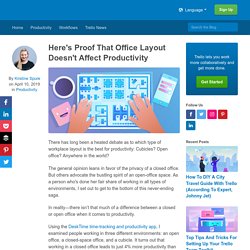
Open office? Anywhere in the world? The general opinion leans in favor of the privacy of a closed office. But others advocate the bustling spirit of an open-office space. As a person who's done her fair share of working in all types of environments, I set out to get to the bottom of this never-ending saga.
In reality—there isn’t that much of a difference between a closed or open office when it comes to productivity. Using the DeskTime time-tracking and productivity app, I examined people working in three different environments: an open office, a closed-space office, and a cubicle. But here's the kicker: the most productive setup (91.1%) of the trio was the bane of every modern worker’s existence—the dreaded cubicle.
The Boss' Guide to Creating a Mentally Healthy Workplace.
Source: TorwaiStudio/Shutterstock Many business leaders assume an employee's mental health is none of their business.
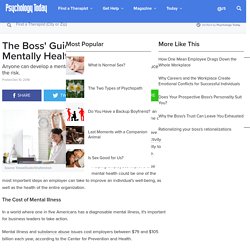
But the way employees think, feel, and behave impacts everything from productivity and communication to their ability to maintain safety in the workplace. Helping employees improve their mental health could be one of the most important steps an employer can take to improve an individual's well-being, as well as the health of the entire organization. article continues after advertisement The Cost of Mental Illness In a world where one in five Americans has a diagnosable mental illness, it's important for business leaders to take action. Mental illness and substance abuse issues cost employers between $79 and $105 billion each year, according to the Center for Prevention and Health. Absenteeism, reduced productivity, and increased health care costs are just a few of the ways mental health issues cost employers money. 1. 2. 3. 4. 5. 6. 7. 8.
Are Our Workplaces Getting Ruder?
How often do you have to deal with people’s rude behavior at work?
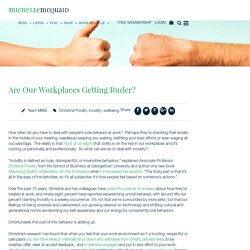
Perhaps they’re checking their emails in the middle of your meeting, needlessly keeping you waiting, belittling your best efforts or even waging all out sabotage. The reality is that most of us report that civility is on the rise in our workplaces and it’s costing us personally and professionally. So what can we do to deal with incivility?
Christine Porath on The Cost of Incivility. Today’s Guest: Christine Porath is an associate professor at the School of Business at Georgetown University.
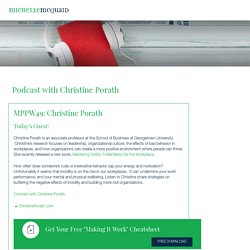
Christine’s research focuses on leadership, organizational culture, the effects of bad behavior in workplaces, and how organizations can create a more positive environment where people can thrive. She recently released a new book, Mastering Civility: A Manifesto for the Workplace. How often does someone’s rude or insensitive behavior zap your energy and motivation? Unfortunately it seems that incivility is on the rise in our workplaces. Connect with Christine Porath: ChristinePorath.com You’ll Learn: [01:48] – Christine defines “incivility” and says that it has become more prevalent in workplaces. [04:44] – Christine explains that the number one thing driving incivility is stress and feeling overwhelmed.
Your Resources: Thanks for listening! Thanks so much for joining me again this week. Also, please leave an honest review for the Making Positive Psychology Work Podcast on iTunes.
Why being respectful to your coworkers is good for business [TED Talk : Christine Porath]
Workplace Environment Affects Mental Health. The workplace environment you spend 40 or 50 hours in per week has a very real and substantial impact on your mental health, according to multiple studies and expert opinions from psychologists all around the world.
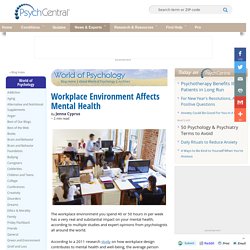
According to a 2011 research study on how workplace design contributes to mental health and well-being, the average person spends 33 percent of their waking time in their workplace on a weekly basis. As such, the physical workplace environment has a major impact on everything from happiness and mood to productivity and focus.
Can You AMP Up Your Workplace?
Study opens door to better sleep, work, health. Courtesy of Harvard Chan School A study has shown the importance of a building's interior environment as it relates to productivity and overall health.
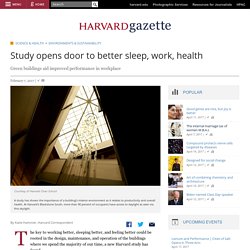
At Harvard's Blackstone South, more than 90 percent of occupants have access to daylight as seen via this skylight. The key to working better, sleeping better, and feeling better could be rooted in the design, maintenance, and operation of the buildings where we spend the majority of our time, a new Harvard study has found. The national study, conducted by researchers at the Harvard T.H. Chan School of Public Health’s Center for Health and the Global Environment (CHGE) and SUNY Upstate Medical, is the first to show that working in high-performing, green-certified buildings can improve employee decision-making using objective cognitive simulations.
Researchers looked at 10 high-performing buildings in five cities across the United States, including Harvard’s double LEED Platinum Blackstone South building.
Surviving the Open Office (Really, It's Not So Bad)
It’s ten o’clock, and I glance up from my first (okay, second) cup of coffee, only to lose my train of thought.
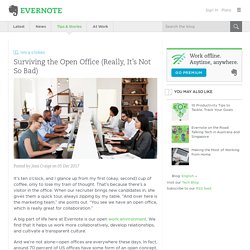
That’s because there’s a visitor in the office. When our recruiter brings new candidates in, she gives them a quick tour, always zipping by my table.
Workspace Design
Workflow. Working Conditions. Professional Relationships. Positive Organizational Psychology. Environment Design. Creative Inspiration.







